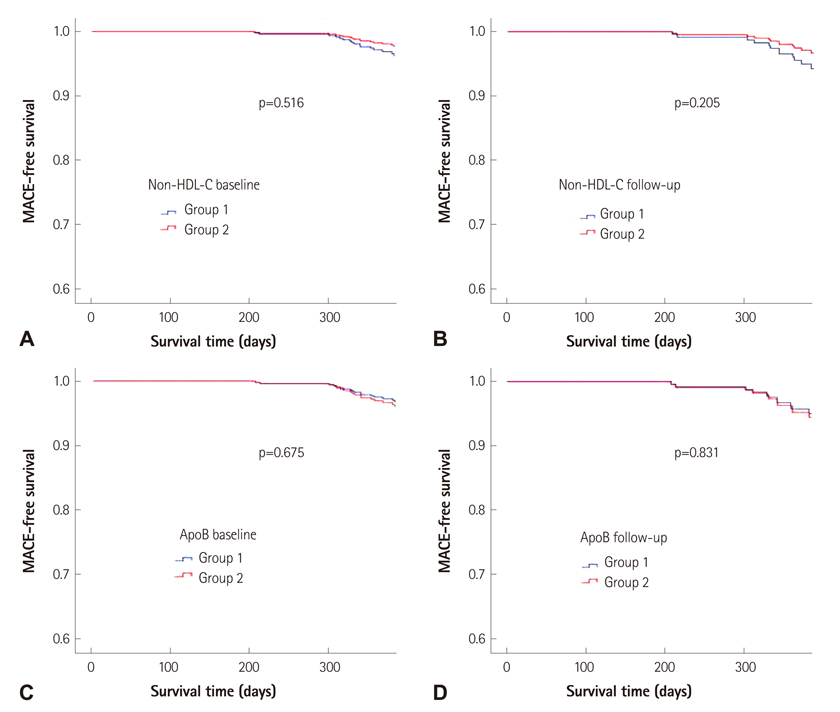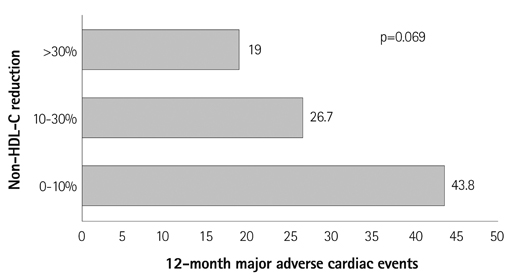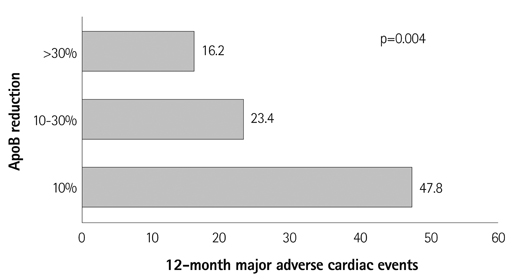Korean Circ J.
2012 May;42(5):319-328. 10.4070/kcj.2012.42.5.319.
Clinical Impact of Non-High Density Lipoprotein-Cholesterol and Apolipoprotein B on Clinical Outcomes in Metabolic Syndrome Patients With Acute Myocardial Infarction Undergoing Percutaneous Coronary Intervention
- Affiliations
-
- 1The Heart Center of Chonnam National University Hospital, Chonnam National University Research Institute of Medical Sciences, Gwangju, Korea. myungho@chollian.net
- 2Apollo Gleneagles Hospital, Kolkata, India.
- KMID: 2028760
- DOI: http://doi.org/10.4070/kcj.2012.42.5.319
Abstract
- BACKGROUND AND OBJECTIVES
Non-high density lipoprotein-cholesterol (non-HDL-C) and apolipoprotein B (ApoB) are markers of atherosclerotic risk and predictors of cardiovascular events. The aim of this study was to evaluate clinical impact of non-HDL-C and ApoB on clinical outcomes in metabolic syndrome (MS) patients with acute myocardial infarction (AMI) undergoing percuatneous coronary intervetion.
SUBJECTS AND METHODS
We analyzed 470 MS patients (64.4+/-12.0 years, 53.6% male) with AMI who were followed-up for 12-month after percutaneous coronary intervention (PCI) from December 2005 to January 2008 in a single center. These patients were divided into 2 groups based on median values of non-HDL-C and ApoB. We studied their baseline and follow-up relation with 12-month clinical outcomes, all-cause death and major adverse cardiac events (MACE).
RESULTS
Mean values of baseline non-HDL-C and ApoB were 141.2+/-43.1 mg/dL and 99.3+/-29.0 mg/dL respectively. During 12-month follow-up 32 MACE (6.8%) and 12 deaths (2.5%) occurred. We observed significant correlation between non-HDL-C and ApoB. Twelve-month MACE and all-cause death after PCI showed no significant relation as non-HDL-C or ApoB levels increased. Follow-up patients (n=306, rate 65%) also did not show significant relation with clinical outcomes. Twelve-month MACE decreased as non-HDL-C and ApoB reduction rates increased.
CONCLUSION
There was no significant association between higher non-HDL-C or ApoB and 12-month clinical outcomes in MS patients with AMI undergoing PCI. ApoB was found to be a better predictor of 12-month MACE than non-HDL-C based on their reduction rates.
MeSH Terms
Figure
Reference
-
1. Ferrannini E, Haffner SM, Mitchell BD, Stern MP. Hyperinsulinaemia: the key feature of a cardiovascular and metabolic syndrome. Diabetologia. 1991. 34:416–422.2. National Cholesterol Education Program (NCEP) Expert Panel on Detection, Evaluation, and Treatment of High Blood Cholesterol in Adults (Adult Treatment Panel III). Third Report of the National Cholesterol Education Program (NCEP) Expert Panel on Detection, Evaluation, and Treatment of High Blood Cholesterol in Adults (Adult Treatment Panel III) final report. Circulation. 2002. 106:3143–3421.3. Ballantyne CM, Andrews TC, Hsia JA, Kramer JH, Shear C. ACCESS Study Group. Correlation of non-high-density lipoprotein cholesterol with apolipoprotein B: effect of 5 hydroxymethylglutaryl coenzyme A reductase inhibitors on non-high-density lipoprotein cholesterol levels. Am J Cardiol. 2001. 88:265–269.4. Lakka HM, Laaksonen DE, Lakka TA, et al. The metabolic syndrome and total and cardiovascular disease mortality in middle-aged men. JAMA. 2002. 288:2709–2716.5. Sattar N, Gaw A, Scherbakova O, et al. Metabolic syndrome with and without C-reactive protein as a predictor of coronary heart disease and diabetes in the West of Scotland Coronary Prevention Study. Circulation. 2003. 108:414–419.6. Grundy SM, Cleeman JI, Daniels SR, et al. Diagnosis and management of the metabolic syndrome: an American Heart Association/National Heart, Lung, and Blood Institute Scientific Statement. Circulation. 2005. 112:2735–2752.7. Lee KH, Jeong MH, Ahn YK, et al. Sex differences of the clinical characteristics and early management in the Korea acute myocardial infarction registry. Korean Circ J. 2007. 37:64–71.8. Sim DS, Kim JH, Jeong MH. Differences in clinical outcomes between patients with ST-elevation versus non-ST-elevation acute myocardial infarction in Korea. Korean Circ J. 2009. 39:297–303.9. Apple FS, Wu AH, Jaffe AS. European Society of Cardiology and American College of Cardiology guidelines for redefinition of myocardial infarction: how to use existing assays clinically and for clinical trials. Am Heart J. 2002. 144:981–986.10. Kini AS. Coronary angiography, lesion classification and severity assessment. Cardiol Clin. 2006. 24:153–162.11. Manginas A, Gatzov P, Chasikidis C, Voudris V, Pavlides G, Cokkinos DV. Estimation of coronary flow reserve using the Thrombolysis In Myocardial Infarction (TIMI) frame count method. Am J Cardiol. 1999. 83:1562–1565.12. Kereiakes DJ, Willerson JT. Metabolic syndrome epidemic. Circulation. 2003. 108:1552–1553.13. Isomaa B, Almgren P, Tuomi T, et al. Cardiovascular morbidity and mortality associated with the metabolic syndrome. Diabetes Care. 2001. 24:683–689.14. Reilly MP, Rader DJ. The metabolic syndrome: more than the sum of its parts? Circulation. 2003. 108:1546–1551.15. Rauchhaus M, Clark AL, Doehner W, et al. The relationship between cholesterol and survival in patients with chronic heart failure. J Am Coll Cardiol. 2003. 42:1933–1940.16. Wang TY, Newby LK, Chen AY, et al. Hypercholesterolemia paradox in relation to mortality in acute coronary syndrome. Clin Cardiol. 2009. 32:E22–E28.17. Cho KH, Jeong MH, Ahn Y, et al. Low-density lipoprotein cholesterol level in patients with acute myocardial infarction having percutaneous coronary intervention (the cholesterol paradox). Am J Cardiol. 2010. 106:1061–1068.18. Gruberg L, Weissman NJ, Waksman R, et al. The impact of obesity on the short-term and long-term outcomes after percutaneous coronary intervention: the obesity paradox? J Am Coll Cardiol. 2002. 39:578–584.19. Gurm HS, Brennan DM, Booth J, Tcheng JE, Lincoff AM, Topol EJ. Impact of body mass index on outcome after percutaneous coronary intervention (the obesity paradox). Am J Cardiol. 2002. 90:42–45.20. Mehta L, Devlin W, McCullough PA, et al. Impact of body mass index on outcomes after percutaneous coronary intervention in patients with acute myocardial infarction. Am J Cardiol. 2007. 99:906–910.21. Prasad A, Stone GW, Aymong E, et al. Impact of ST-segment resolution after primary angioplasty on outcomes after myocardial infarction in elderly patients: an analysis from the CADILLAC trial. Am Heart J. 2004. 147:669–675.22. Tespili M, Guagliumi G, Valsecchi O, et al. In-hospital clinical outcome in elderly patients with acute myocardial infarction treated with primary angioplasty. Ital Heart J. 2003. 4:193–198.23. Pischon T, Girman CJ, Sacks FM, Rifai N, Stampfer MJ, Rimm EB. Non-high-density lipoprotein cholesterol and apolipoprotein B in the prediction of coronary heart disease in men. Circulation. 2005. 112:3375–3383.24. Sniderman AD, St-Pierre AC, Cantin B, Dagenais GR, Després JP, Lamarche B. Concordance/discordance between plasma apolipoprotein B levels and the cholesterol indexes of atherosclerotic risk. Am J Cardiol. 2003. 91:1173–1177.25. Sattar N, Williams K, Sniderman AD, D'Agostino R Jr, Haffner SM. Comparison of the associations of apolipoprotein B and non-high-density lipoprotein cholesterol with other cardiovascular risk factors in patients with the metabolic syndrome in the Insulin Resistance Atherosclerosis Study. Circulation. 2004. 110:2687–2693.26. Sniderman AD. Apolipoprotein B versus non-high-density lipoprotein cholesterol: and the winner is. Circulation. 2005. 112:3366–3367.27. Han JH, Park HS, Kim JA, Kim SM. Apolipoprotein B is a better marker than non-HDL-cholesterol for the metabolic syndrome in Koreans. Atherosclerosis. 2008. 197:333–338.
- Full Text Links
- Actions
-
Cited
- CITED
-
- Close
- Share
- Similar articles
-
- Differences in the Korea Acute Myocardial Infarction Registry Compared with Western Registries
- Clinical Outcomes according to the Achievement of Target Low Density Lipoprotein-Cholesterol in Patients with Acute Myocardial Infarction
- Clinical Benefit of Statins in Korean Patients with Acute Myocardial Infarction: Experience of the Korea Acute Myocardial Infarction Registry
- The Prognostic Impact of Hypertriglyceridemia and Abdominal Obesity in Acute Myocardial Infarction Patients Underwent Percutaneous Coronary Intervention
- Acute Profound Thrombocytopenia after Using Abciximab for No-Reflow during Primary Percutaneous Coronary Intervention for ST-Segment Elevation Myocardial Infarction




